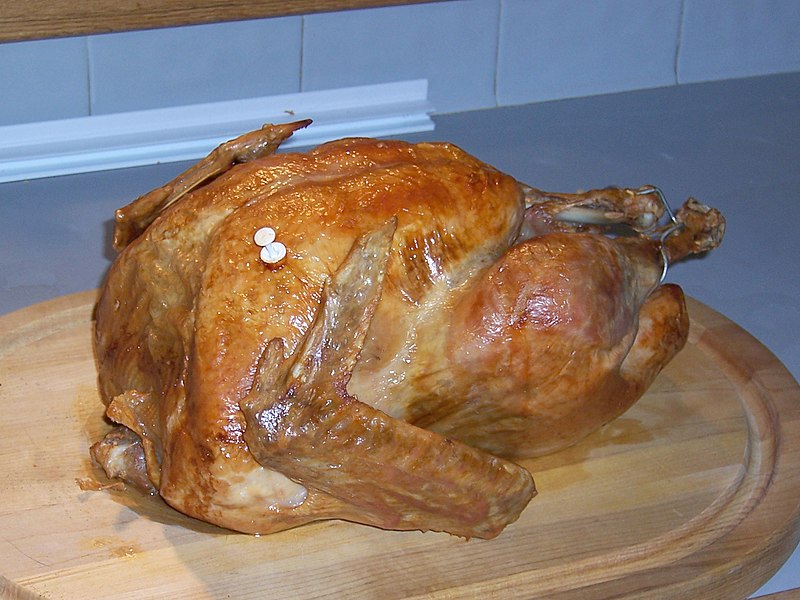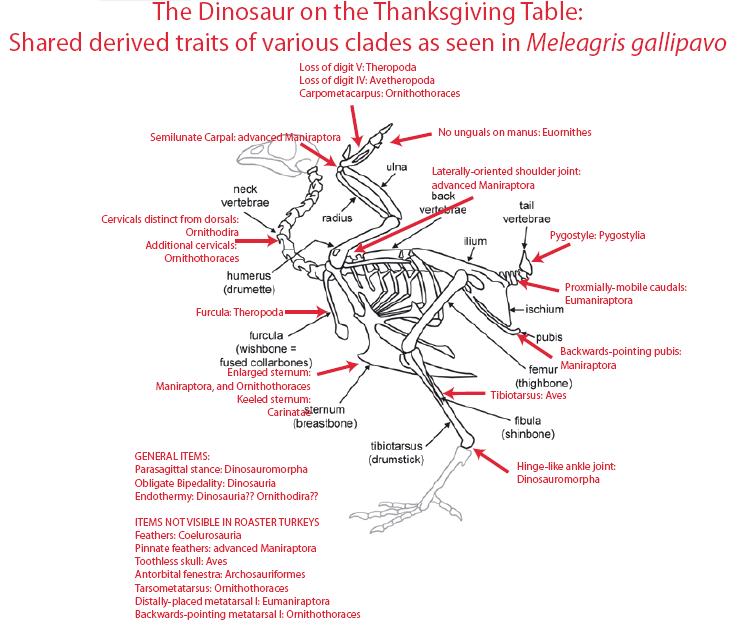
If you recall
my post from back around Thanksgiving, the Wild Turkey -- like all birds -- is a modern day dinosaur. What better opportunity to share this little fact with your friends and family than over the Christmas Turkey?
Below are some resources for turning the remains of your holiday feast into a biology lesson, but before we get into details I want to first answer a simple question:
What exactly is a dinosaur anyway?
Dinosaur's are a group of (mostly extinct) reptiles that arose around the early Triassic period about 230 million years ago (mya). They persisted until the mass extinction event that occurred 65mya at the end of the Cretaceous period, (also the end of the Mesozoic era and start of the Cenozoic era), when all of the dinosaur lineages save modern birds died out.
To put this talk of dinosaurs and birds into perspective, lets take a crash course in vertebrate taxonomy. Starting with the ancestor of all land vertebrates, we can follow evolution forward to the present, noting major points of divergence along the way. We're of course skipping a lot, taking the fast track from the first vertebrate land animals to modern day birds.
The first amphibian-like terrestrial tetrapods appeared over 350mya (Late Devonian into the Carboniferous period), with the
Synapsids (whose descendants became the modern mammals) splitting off 25+ million years later. Another 25 million years or so later, ancestral turtles and other
Testudines appeared, then the
sphenodonts (the tuatara) and the
squamates (lizards and snakes), then
crocodilians, then
dinosaurs and
birds.
These relationships can be summarized as follows (here I've included proper group names as well as extant representatives):
- Amniotes - Descendants of the first egg-laying terrestrial vertebrates (~ 340mya) split around ~325mya
- Synapsids - Mammalian ancestors
- ...
- Mammals ~ 200 mya
- Primates ~ 55+ mya
- Human-Chimp Split ~ 5-10 mya
- Saurapsids - Modern Reptilians
- Anapsids - Turtles
- Diapsids - Other modern reptiles (including birds), split ~ 300mya
- Lepidosauria -Tuatara, Lizards and Snakes
- Sphenodonts - Tuatara
- Squamates - Lizards, Snakes
- Archosauria - Crocodilians, Dinosaurs (including birds)
- Dinosauria - Two dinosaur groups diverged ~250 mya
- Ornithischia - "bird-hipped", beaked - but not birds!
- Saurischia - "lizard-hipped", toothed ancestors of birds.
- Sauropodomorpha - big herbivores like Diplodicus.
- Theropoda - bipedal carnivores like T. rex, Velociraptor and...
- Aves - modern birds, originating ~ 150mya
Whew! So to sum up, birds have been around since their divergence from the other dinosaurs during the Cretaceous period (145-65mya), and are the only surviving Dinosaurs of the big Cretaceous extinction 65mya. Their closest living relatives are the Crocodilians (together with dinosaurs and other relatives, these are the
Archosaurs), then the lizards and snakes (which all together form the
Diapsid reptilians), then turtles (all together, the
Saurapsids). After all the reptilians, the next closest relatives are the mammals (all together, these are all of the living
Amniotes), then amphibians, fishes, etc.
So how do you bring all this information to the dinner table? Well the easiest way to see the relationship between dinosaurs and birds is from the differences and similarities in their skeletal structure.
Other ideas can be found
here, and for a nice reference you can bring with you to the Christmas dinner table...
Source: Image from here, modified by Tom Holtz here.
Resources:
- Prothero, S. 2007. Evolution: What the Fossils Say and Why It Matters. Columbia Univ. Press.
- The Dinosauria, from the University of California Museum of Paleontology website.
- Wikipedia (links above).
- Wedel, Matt. Your Holiday Dinosaur, University of California Museum of Paleontology website.
- Holtz, Tom. Your Thanksgiving/Christmas Therapod from Dave Hone's Archosaur Musings.












